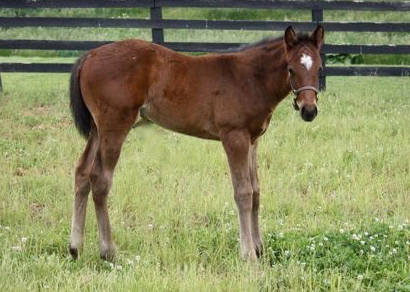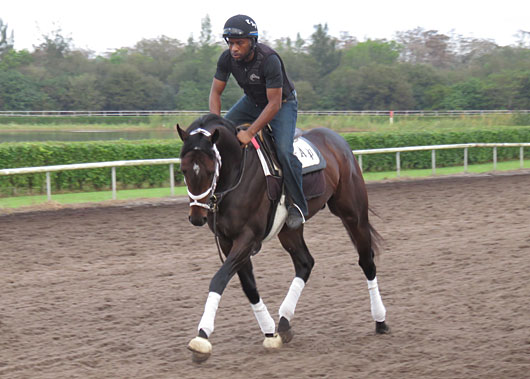On June 20, 2011, the Lady Blunt Stradivarius, made by Italian Antonio Stradivari in 1721 sold at public auction for $15.9 million. A little over three years later, a yearling colt, later to be named Stradivari, failed to meet his reserve at the Keeneland September yearling sale and was bought back by his owner and breeder John Gunther for $335,000.
In less than a week, that same colt could be worth about the same amount of money as the violin, whose maker he was named after.
That is if he can knock off the undefeated Kentucky Derby winner Nyquist in Saturday’s Preakness Stakes. And if he can follow that up with a Belmont Stakes victory, who knows how much he’ll be worth.
So, just who is Stradivari and why would anyone think he has a shot to upset five-time grade I winner Nyquist when he has never even competed in a stakes race and has made only three lifetime starts? And he hasn’t even won all of them, finishing fourth, beaten 8 1/2 lengths, in his career debut last November
There lies the always intriguing unknown factor that hovers over Stradivari and could very well get him bet down to third or fourth choice in the Preakness. The reason for the intrigue can be found in Stradivari’s last two races, which he won by 11 1/4 lengths and 14 1/2 lengths, respectively.
It was his first victory, an off-the-turf maiden race at Gulfstream in December, that drew the attention of the powerful Coolmore gang, who purchased part interest in the son of Medaglia d’Oro and then watched as he destroyed an allowance field at Keeneland on April 17, earning a powerful 100 Beyer speed figure and putting himself right in the Preakness Stakes picture, where he will attempt to emulate Bernardini and capture the second leg of the Triple Crown off only three career starts.
There is only so much one can deduce from Stradivari’s races before deciding whether this is a major star in the making or simply a very good horse who beat up on inferior competition in maiden and allowance company. Can such a horse actually hope to upset a champion and Kentucky Derby winner who has never tested defeat in eight career starts, not to mention proven stakes winners Exaggerator and Gun Runner?
As mentioned earlier, that is the intrigue that surrounds this colt, who no doubt will have his supporters as well as his doubters. You can jump on his bandwagon now or wait for the Preakness and jump on then if he proves to be as good as he’s looked in his last two races and can skyrocket to the head of the class in one launching.
It was no coincidence that John Gunther named this particular colt Stradivari. Gunther’s daughter, Tanya, a former investment banker who now helps manage and plan the matings for her father’s 330-acre Glennwood Farm operation, said he is a big music lover who always wanted Tanya to play the violin, which she never took up, being too busy riding horses. Also, the colt’s dam is named Bending Strings, who was owned and bred by Gunther and won or placed in 13 stakes. And, Medaglia d’Oro is an Italian brand of espresso coffee, so it all adds up – music lover, violin, strings, Italian.
The best thing you can say about young Stradivari is nothing much. Many times, it’s the horses who do everything right and who you don’t take much notice of that are the ones who develop into top-class racehorses.
And the Gunthers are not unfamiliar with top-class racehorses, having bred or co-bred grade I winners Stay Thirsty, Materiality, Stevie Wonderboy, and First Samurai.
Stradivari was born on April 24, 2013 at 9:28 p.m., and as Tanya said, “He even foaled at a reasonable hour and was standing in just under an hour later. From a foal through to his yearling days he was easy to handle and be around. This trait has followed him through to his racing and training days as well. (Trainer) Todd Pletcher has told me on a number of occasions what a great mind he has.
“We don't have a training track at the farm so the breaking-in process doesn't allow for a lot of competitiveness to show through. I remember that he had done a ‘pirouette’ equine-style one day and the rider remarked about his agility. He also was smart and picked things up easily without the awkwardness of some horses at that early stage.”
The Gunthers consigned Stradivari to the Keeneland September sale and obviously feel extremely fortunate that he failed to meet his reserve.
“We thought he was our top yearling colt in the sale, and being a Medaglia ‘Oro colt in Book 1, he had a lot of looks and interest,” Tanya said. “We were disappointed and frankly somewhat perplexed when he didn’t sell, but not at all unhappy to keep him. My dad and I loved him and our guys that worked with him on the farm did as well. He was a classy individual to work around and showed himself at the sale like a pro. He had, and still has, great balance, athleticism and a big walk. Perhaps he could have been bigger to suit some people but he was a late April foal so a nice medium sized colt is how he seemed to our eyes.
“After he RNA’d, we shook our heads and loaded him up and took him home - on to the next adventure. The horse was broken at the farm and showed his athleticism again at that stage, gaining top marks from his rider. We sent him to Ocala to Hidden Brook South for his 2-year-old baby training and soon he was regarded as one of the training center's top colts.”
Tanya said she struggled to come up with something more exciting to say about him, but because he was so straightforward and professional and never caused even the slightest problem, there are no adventures or misadventures to discuss.
So, why try to sell him instead of racing him themselves?
“We put most of our horses up for auction,” Tanya said. “There have been a few fillies we have kept to continue a family that we like and kept the odd yearlings that we guessed might not be commercial or got hurt at an untimely point. I also have a favorite mare whose foals I decided I would try to keep after selling the first two.”
On both those occasions, Tanya cried when they had to sell them, but she said, ‘Don’t tell.’ Sorry, I couldn’t resist.
“Although we love the racing, the reality is that our best yearlings are the ones that tend to make money to carry the ones that don’t,” she continued. “So without the benefit of a crystal ball and the ability to keep them all safe from injury, it makes financial sense to sell when we feel the return and the valuation makes sense.
“We did comment amongst ourselves about keeping Stradivari a number of times before and even during the sale because he showed himself so consistently well every day. My dad set what he thought was a fair reserve and, when he didn’t sell, we might have been even a little happy to take him home.
When Tanya saw the grown-up version of Stradivari after he arrived in Kentucky this year, she was impressed by his overall beauty and how well he moved under tack.
“It wasn’t quite the same as when I saw Materiality again at Churchill Downs on Derby week,” she recalled. “He was quite a big horse comparatively and there was a bigger change in him since we had parted ways with him as a yearling. Stradivari seemed balanced and athletic as before, just bigger and stronger and more mature. My dad echoed the same thoughts when he saw him work at Churchill on Derby morning (six furlongs in 1:14 2/5).”
When Stradivari broke his maiden at Gulfstream, it was on Tanya’s sister’s birthday, which she hoped was a good omen.
“When he left his foes behind and kept extending his winning margin all the way to the wire, in both his wins, I had my hand covering my mouth by the end of his run and a glint of something wet and blurry in the eye (Uh, she cried again). To have a homebred run like that fills you with awe, and in that moment it makes up for all of the tough times and disappointments. My dad said that when Stradivari won at Gulfstream, the thought crossed his mind that this might be the best horse he has ever bred.
“Of course, it’s still early, but he has been high on this colt for some time. When Stradivari ran at Keeneland, we were both very nervous because we so much wanted the horse to run well and not just for us but for our new partners. Having partners makes the pressure somehow greater.”
Now, that pressure will hit a feverish pitch when Stradivari, despite having only three career starts, attempts to dethrone the mighty and so far invincible Nyquist.
“Nyquist was flawless in the Derby and it is hard to find any vulnerability going into the Preakness,” Tanya said. “That said, we are looking forward to the possibility of running Stradivari in the Preakness and I hope to see the colt show what he can do on the big day.”
Tanya and her father realize the task they are facing, but all she has to do is look back at the power and grace Stradivari exhibited at Keeneland, and how easily he disposed of a solid allowance field, with John Velazquez’ only movement coming when he looked back four times, as track announced Kurt Becker said, “Look at Stradivari. He hasn’t been asked for a thing and just has a cakewalk here.”
To watch those fluid strides and the way he ran straight as the proverbial arrow the length of the stretch, and the ease with which he powered away from his opponents, it has to boost her confidence. And it was that performance that makes Stradivari such an intriguing addition to the Preakness field.
“When he ran off the screen at Keeneland, it was really a ‘Wow’ moment,” Tanya said. “I was speechless, and sometimes I think it is still sinking in for both my dad and me.”
John Gunther never got to hear Tanya play the violin, but this Saturday they hope the name Stradivari will be music to their ears.

Stradivari as a foal - Photo courtesy of Tanya Gunther

Stradivari at Palm Beach Downs - Photo courtesy of Tanya Gunther




